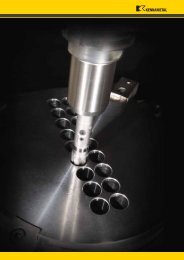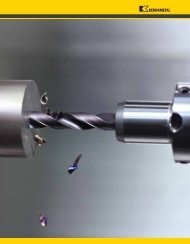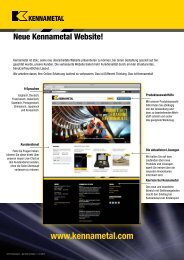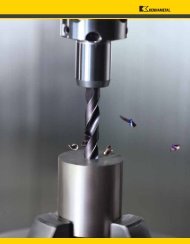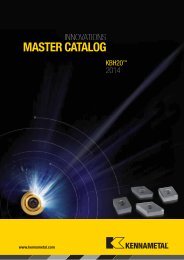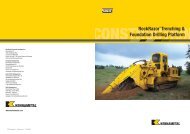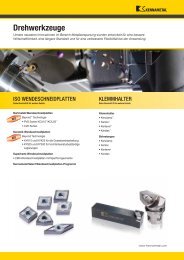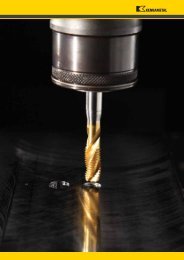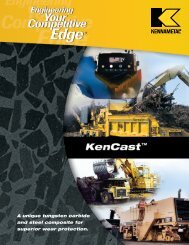You also want an ePaper? Increase the reach of your titles
YUMPU automatically turns print PDFs into web optimized ePapers that Google loves.
<strong>Technical</strong> <strong>Information</strong><br />
<strong>Technical</strong> <strong>Information</strong><br />
Balancing<br />
Balancing<br />
Kennametal offers a range of balanced and balanced-by-design<br />
toolholders capable of extending spindle and tool life and improving<br />
part quality at higher machining speeds.<br />
Definitions for Balance<br />
Standard Toolholder<br />
A toolholder that may contain uncorrected features (unbalanced drive slots,<br />
notches, locking screws, etc.). Standard toolholders have no compensating<br />
features added to correct balance, used in basic, low-speed applications.<br />
Balanced-by-Design<br />
A toolholder designed with compensating features to correct any unbalance<br />
caused by uneven drive slots, notches, locking screws, etc. The balanced<br />
toolholder is capable of being used in high-speed applications. Small, residual<br />
unbalance may result due to normal manufacturing tolerances within the shank<br />
standards.<br />
When machining at higher speeds, responsible machining practices must<br />
be observed. Unbalance is caused by uneven mass distribution in the tool<br />
or toolholder. Potential sources of unbalance are movable parts (adjustable<br />
cartridges, set screws, spindle spring pack, and clamping mechanisms),<br />
manufacturing tolerances, and design.<br />
Balanceable<br />
A toolholder with a built-in mechanism that can adjust to correct any<br />
unbalance inaccuracies incurred during normal manufacturing. The fully<br />
assembled tool (toolholder and cutting tool) can be balanced as a system<br />
using a balancing device.<br />
Balanced<br />
A toolholder has been balanced to predetermined specification after manufacture<br />
by checking the balance condition with a balancing device. This may be followed<br />
by physically removing material from the toolholder, such as holes and/or slots.<br />
Forces caused by unbalance increase with the rotational speed squared.<br />
Excessive unbalance can cause premature wear to the tool and spindle bearing,<br />
which can adversely affect surface finish and accuracy.<br />
(continued)<br />
M74 www.kennametal.com





